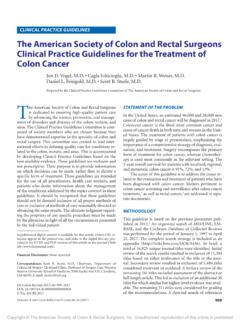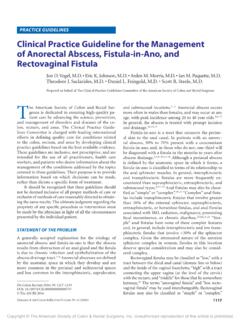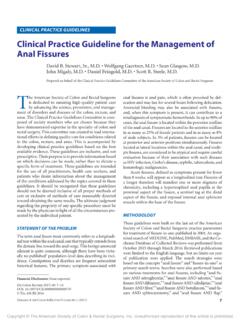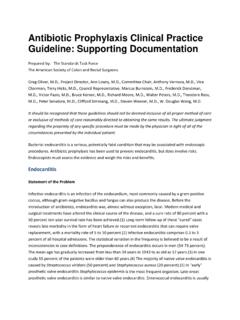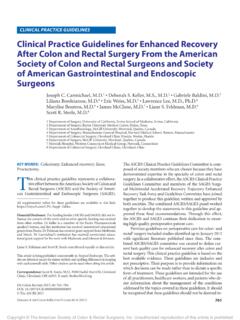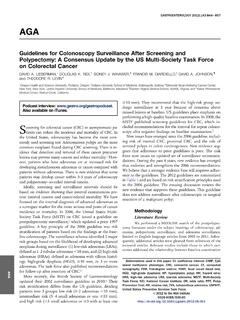Transcription of The American Society of Colon and Rectal Surgeons Clinical ...
1 Downloadedfrom C33fy907 TbIFyHx640yafcu/EMfLBj0ena7lfLfVXefdPtD2 mEHxq/BpP2kvObheZQ/k1t9qDSwPpsO8 GTaUdiwuQjK1pQWMNN68 JzRBGSAL9MK1M9Zl+7sUEot+0vYm+Up9l3 OtRZ4=on 09/29/2020 Downloadedfrom C33fy907 TbIFyHx640yafcu/EMfLBj0ena7lfLfVXefdPtD2 mEHxq/BpP2kvObheZQ/k1t9qDSwPpsO8 GTaUdiwuQjK1pQWMNN68 JzRBGSAL9MK1M9Zl+7sUEot+0vYm+Up9l3 OtRZ4=on 09/29/2020 Copyright The American Society of Colon & Rectal Surgeons , Inc. Unauthorized reproduction of this article is OF THE Colon & RECTUM VOLUME 63: 9 (2020) The American Society of Colon and Rectal Surgeons (ASCRS) is dedicated to ensuring high-quality pa-tient care by advancing the science, prevention, and management of disorders and diseases of the Colon , rectum, and anus. The Clinical Practice Guidelines Committee is composed of Society members who are chosen because they have demonstrated expertise in the specialty of Colon and Rectal surgery.
2 This committee was created to lead interna-tional efforts in defining quality care for conditions related to the Colon , rectum, and anus and to develop Clinical prac-tice guidelines based on the best available evidence. Although they are not proscriptive, these guidelines provide informa-tion on which decisions can be made and do not dictate a specific form of treatment. These guidelines are intended for the use of all practitioners, health care workers, and patients who desire information about the management of the condi-tions addressed by the topics covered in these guidelines should not be deemed inclusive of all proper methods of care nor exclusive of methods of care reasonably directed toward obtaining the same results.
3 The ultimate judgment regarding the propriety of any spe-cific procedure must be made by the physician in light of all the circumstances presented by the individual OF THE PROBLEMC olorectal cancer remains the third most common cancer for both men and women, and the second leading cause of can-cer-related deaths in the United States annually. It is projected that 145,600 new colorectal cancer cases will have been diag-nosed and an estimated 51,020 deaths from colorectal cancer will have occurred in It is difficult to estimate statistics attributable specifically to Rectal cancer because, historically, much of the reporting for Rectal cancer has been combined with Colon cancer as the single disease entity of colorectal cancer .
4 1 Overall, the incidence of colorectal cancer has de-clined over the past decades, largely because of risk factor modification and However, the 18- to 50-year age group represents a unique cohort of patients in whom the incidence of Rectal cancer has been increasing. In contrast to overall trends, Rectal cancer incidence increased by an-nually in younger adults between 1990 and an effort to ensure that patients with Rectal can-cer receive appropriate care using a multidisciplinary approach, the ASCRS collaborated with a multispecialty effort to develop the National Accreditation Program in Rectal cancer to create educational modules and a set of Clinical standards focusing on program management, Clinical services, and quality improvement regarding rec-tal ,4 Because Rectal cancer management involves The American Society of Colon and Rectal Surgeons Clinical Practice Guidelines for the Management of Rectal CancerY.
5 Nancy You, , Karin M. Hardiman, Andrea Bafford, Vitaliy Poylin, Todd D. Francone, , Kurt Davis, Ian M. Paquette, Scott R. Steele, , Daniel L. Feingold, On Behalf of the Clinical Practice Guidelines Committee of the American Society of Colon and Rectal Surgeons1 Department of Surgical Oncology, University of Texas MD Anderson cancer Center, Houston, Texas2 University of Alabama at Birmingham, Birmingham, Alabama3 Department of Surgery, University of Maryland, Baltimore, Maryland4 Gastrointestinal Surgery, Northwestern University Feinberg School of Medicine, Chicago, Illinois5 Department of Surgery, Tufts University Medical School. Boston, Massachusetts6 Department of Surgery, Louisiana State University School of Medicine, New Orleans, Louisiana7 Department of Surgery, University of Cincinnati, Cincinnati, Ohio8 Department of Colorectal Surgery, Cleveland Clinic, Cleveland, Ohio9 Section of Colorectal Surgery, Rutgers University, New Brunswick, New JerseyEarn Continuing Education (CME) credit online at This activity has been approved for AMA PRA Category I Dis Colon Rectum 2020; 63: 1191 1222 DOI: The ASCRS 2020 Clinical PRACTICE GUIDELINESC opyright The American Society of Colon & Rectal Surgeons , Inc.
6 Unauthorized reproduction of this article is ET AL: MANAGEMENT OF Rectal CANCER1192multiple disciplines working in conjunction with one another, the surgical guidelines presented here must be viewed within that context and represent only a portion of the treatment necessary for the optimal care of patients with Rectal cancer . Colorectal cancer screening , bowel preparation, enhanced recovery pathways, surveillance af-ter curative treatment, and prevention of thromboembolic disease, while relevant to the management of patients with Rectal cancer , are beyond of the scope of these guidelines and are addressed in other 9 A guideline fo-cusing on colorectal surgery and frailty is guidelines are based on the last set of ASCRS Practice Parameters for the Management of Rectal cancer published in A systematic search of MEDLINE, PubMed, Em-base, and the Cochrane Database of Collected Reviews was performed from January 1, 2013 through January 15, 2020.
7 Individual literature searches were conducted for each of the different sections of the guideline (Fig. 1). An addi-tional limitation to core Clinical journals was applied if the initial word combination search returned more than 500 articles. Directed searches using embedded references from primary articles were performed in selected circumstances. The 1812 screened articles were evaluated for their level of evidence, favoring Clinical trials, meta-analysis/systematic reviews, comparative studies, and large registry retrospec-tive studies over single institutional series, retrospective reviews, and peer-reviewed, observational studies. Addi-tional references identified through embedded references and other sources as well as practice guidelines or consen-sus statements from relevant societies were also reviewed.
8 A final list of 361 sources was evaluated for methodologic quality, the evidence base was examined, and a treatment guideline was formulated by the subcommittee for this guideline. The final grade of recommendation and level of evidence for each statement were determined using the Grades of Recommendation, Assessment, Development, and Evaluation system (Table 1). When agreement was in-complete regarding the evidence base or treatment guide-line, consensus from the committee chair, vice chair, and 2 assigned reviewers determined the outcome. Members of the ASCRS Clinical Practice Guidelines Committee worked in joint production of these guidelines from inception to final publication. Recommendations formulated by the subcommittee were reviewed by the entire Clinical Practice Guidelines Committee.
9 Final recommendations were ap-proved by the ASCRS Executive Council. In general, each ASCRS Clinical Practice Guideline is updated every 5 years. No funding was received for preparing this guideline, and the authors have declared no competing interests related this material. This guideline conforms to the Appraisal of Guidelines for Research and Evaluation (AGREE) the RectumThe lower limit of the rectum is usually defined by the ano- Rectal ring, an anatomic landmark palpable on physical ex-amination or visible radiographically as the upper border of the anal sphincter and puborectalis The upper limit of the rectum has been variably defined by the splay-ing of the teniae coli, the sacral promontory, the proximal valve of Houston, or the level of the peritoneal reflection.
10 A recent consensus conference defined the point of the sig-moid take-off (ie, the junction of the sigmoid mesocolon and mesorectum) as seen on cross-sectional imaging as the upper limit of the Given that the correlation a-mong these landmarks is imperfect and the presence of all 3 valves of Houston is inconsistent, the upper limit of the rectum, from a Clinical perspective, can be somewhat elu-sive. In practice, the location of a Rectal cancer is most com-monly assessed by the distance from its distal margin to the anal verge, defined as the beginning of the hair-bearing skin. Tumors within 15 cm of the anal verge are typically classified as Rectal cancers, although the total length of the rectum can vary by body habitus and ASSESSMENTE valuation1.
